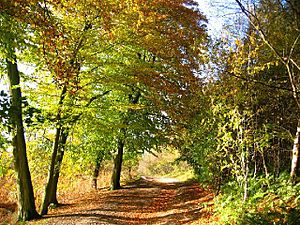Battle of Winnington Bridge facts for kids
Quick facts for kids Battle of Winnington Bridge |
|||||||
|---|---|---|---|---|---|---|---|
| Part of Booth's Uprising | |||||||
 A plaque on the modern bridge commemorating the battle |
|||||||
|
|||||||
| Belligerents | |||||||
| Commanders and leaders | |||||||
| General John Lambert | Sir George Booth Sir Edward Broughton |
||||||
| Strength | |||||||
| 5,000 | 4,000 | ||||||
| Casualties and losses | |||||||
| one | Thirty | ||||||
The Battle of Winnington Bridge happened on August 19, 1659. Many people call it the last battle of the English Civil War. It was part of a Royalist rebellion called Booth's Uprising in north-west England and Wales.
In this battle, an army of about 5,000 soldiers, led by General John Lambert, fought against a rebel army of 4,000 men. The rebel army was led by Sir George Booth. General Lambert's army won.
Contents
Why the Battle Happened
The Start of Booth's Uprising
The rebels, led by Sir George Booth, first gathered in Warrington on August 1. This rebellion was part of a bigger plan to bring back Charles II, who was living in exile. The rebels wanted to take advantage of the political problems in England at the time.
While the main rebellion was quickly stopped, Booth had some success in his local area. He took control of the city of Chester and gathered between 3,000 and 4,000 followers. Other places like Liverpool and parts of north-east Wales also joined the rebels.
Lambert's Army Marches
Booth first started marching towards Manchester. But he soon realized he was on his own. He turned back when he heard that government forces, led by General John Lambert, were coming to stop him.
Even though Booth had been a Parliamentarian soldier before, he wasn't sure what to do. He tried to talk with Lambert while also trying to move his army back to the safety of Chester.
General Lambert left London on August 6. His army moved quickly. By August 15, Lambert and his main army were in Nantwich. Another force was coming from the north, and a group of 1,500 soldiers was ordered to sail from Dublin to secure the western side of the rebel areas.
Lambert was heading straight for Chester. But when he heard that Booth's army, estimated at 4,000 to 5,000 men, was near Northwich, he changed direction. He moved to cut off the rebels near Delamere Forest.

Lambert's fast advance surprised the rebels. Only a quick retreat saved them from being defeated right there. On the evening of August 18, Lambert's scouts found Booth's rearguard in Delamere Forest. As it got dark, both armies stopped for the night. Lambert stayed in Weaverham, and Booth was a few miles east in Northwich.
The Battle of Winnington Bridge
Rebel Positions
On the morning of August 19, Lambert discovered that the rebels had set up their positions north of the River Weaver. Booth's army held the river crossing at Winnington Bridge. They placed some soldiers near the bridge to fight first. Most of his army was on high ground north of the river, protected by steep slopes and a ditch.
Lambert's Attack
Lambert attacked strongly. He pushed back Booth's soldiers from Hartford all the way to Winnington Bridge. An attack on the bridge by one of Lambert's regiments met with little resistance. It was later said that many of Booth's soldiers had problems with their weapons or didn't have enough gunpowder. It was also reported that Booth had left most of his supplies in Chester by mistake.
Many of the rebel foot soldiers, led by Sir Edward Broughton, ran into nearby enclosed areas. Lambert's soldiers were too tired to chase them, and the hedges kept the rebels safe from cavalry.
Cavalry Clash
With the bridge cleared, Lambert moved his cavalry forward to deal with the rest of Booth's army. The narrow, steep lanes leading uphill from the bridge made it hard for the cavalry to move. However, Lambert's cavalry managed to fight the rebel cavalry. After a short fight, the rebel cavalry broke and scattered.
Some reports say that most of Booth's troops simply ran away. But Lambert himself said that "they fought gallantly at the first" and that both sides fought "like Englishmen." The group of rebels still in Northwich were attacked by government dragoons and fled towards Manchester.
Aftermath of the Battle
Lambert did not order his soldiers to chase the fleeing rebel foot soldiers. He supposedly said, "alas, these are forced and hired," meaning they were forced to fight or paid to do so.
Lambert reported only one death on his side, while 30 rebels were killed or wounded. About 200 prisoners were taken and held overnight in Northwich church.
What Happened Next
Most of the rebel leaders, who were wealthy gentlemen, fled after the battle. They later surrendered.
Chester opened its gates to Lambert on August 21. Liverpool surrendered shortly after. Within a week, the remaining parts of Cheshire and Lancashire were back under government control.


